He joins in minimal physical activity
VerifiedAdded on 2022/08/28
|8
|1106
|15
AI Summary
Contribute Materials
Your contribution can guide someone’s learning journey. Share your
documents today.
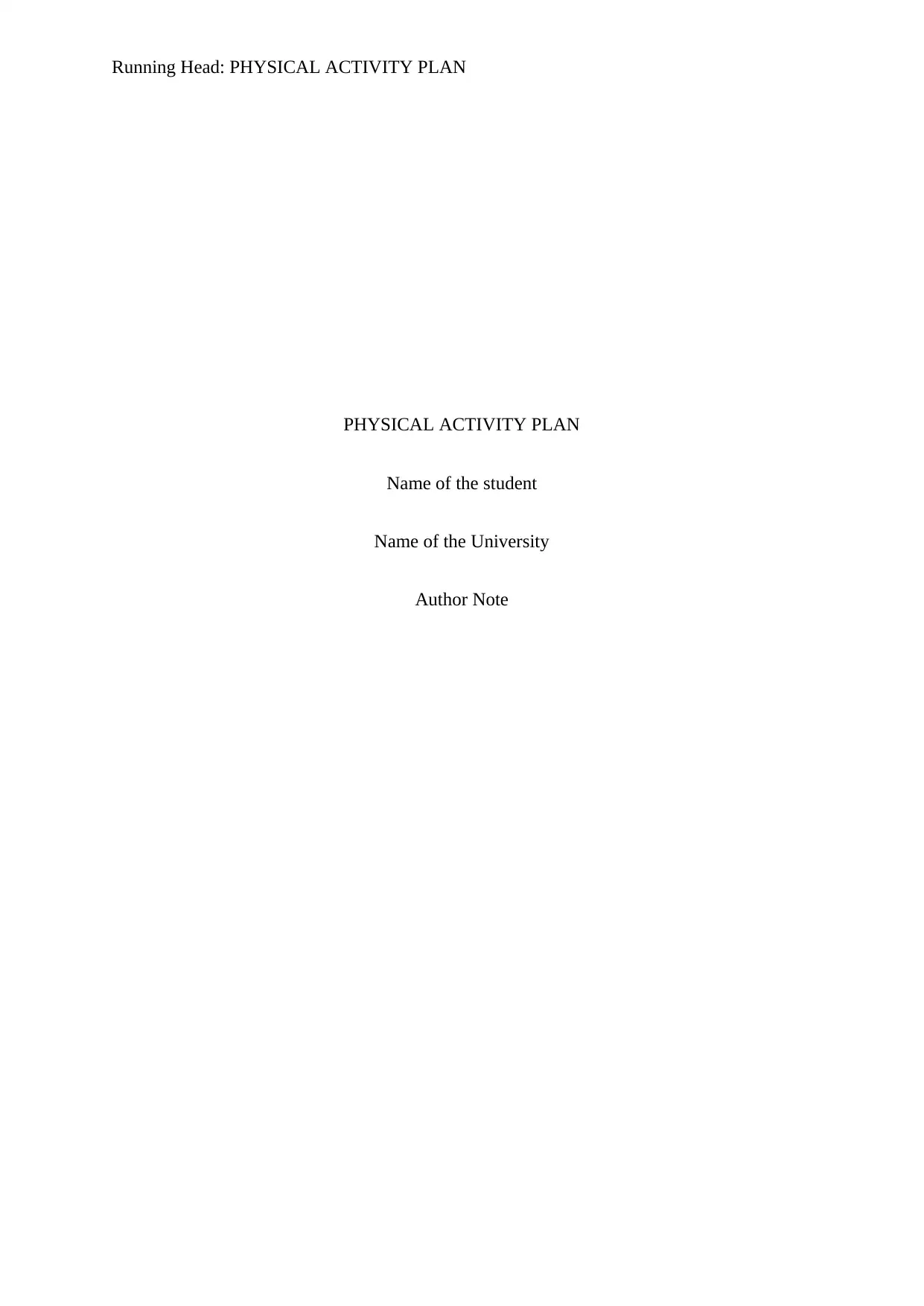
Running Head: PHYSICAL ACTIVITY PLAN
PHYSICAL ACTIVITY PLAN
Name of the student
Name of the University
Author Note
PHYSICAL ACTIVITY PLAN
Name of the student
Name of the University
Author Note
Secure Best Marks with AI Grader
Need help grading? Try our AI Grader for instant feedback on your assignments.
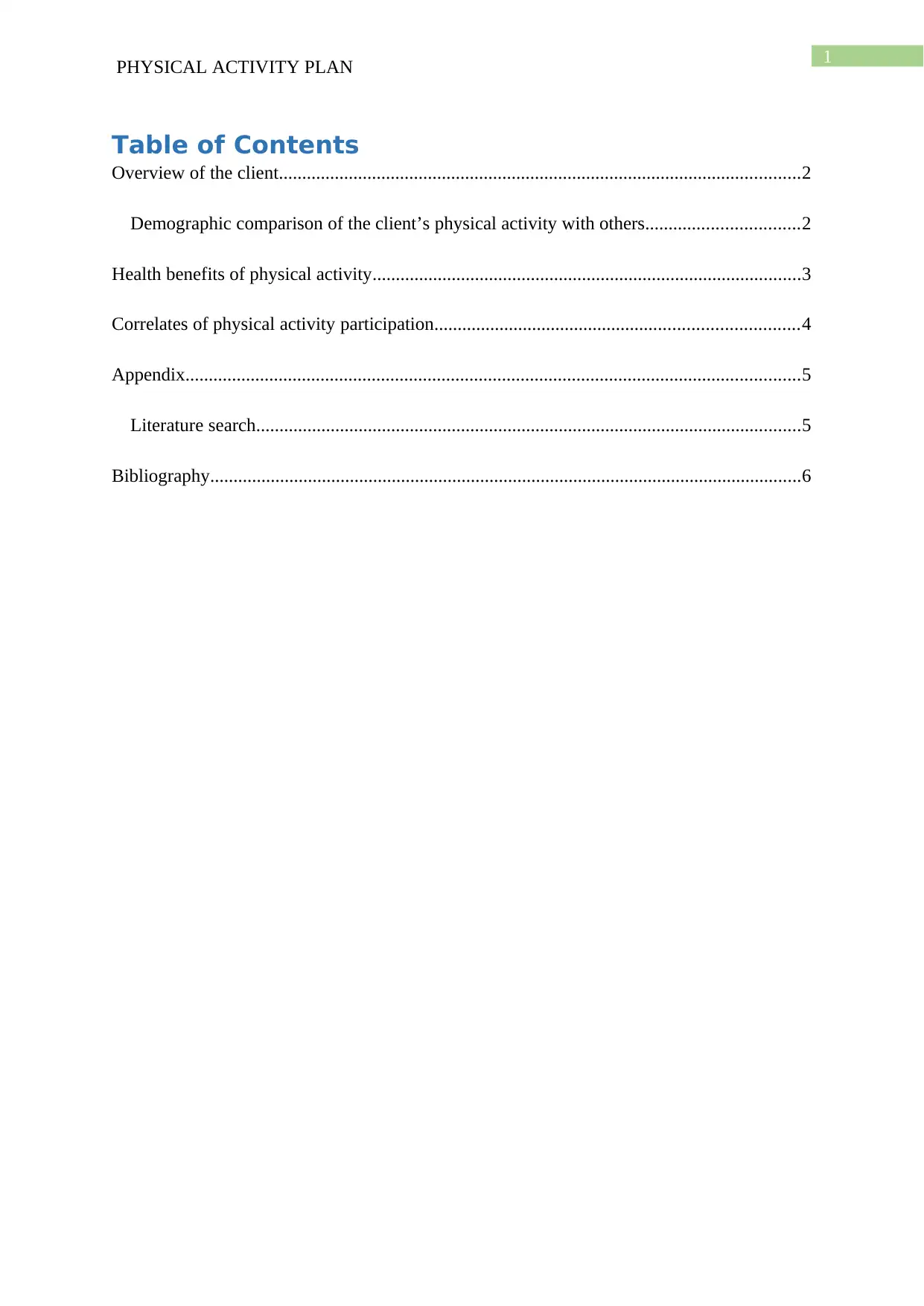
1
PHYSICAL ACTIVITY PLAN
Table of Contents
Overview of the client................................................................................................................2
Demographic comparison of the client’s physical activity with others.................................2
Health benefits of physical activity............................................................................................3
Correlates of physical activity participation..............................................................................4
Appendix....................................................................................................................................5
Literature search.....................................................................................................................5
Bibliography...............................................................................................................................6
PHYSICAL ACTIVITY PLAN
Table of Contents
Overview of the client................................................................................................................2
Demographic comparison of the client’s physical activity with others.................................2
Health benefits of physical activity............................................................................................3
Correlates of physical activity participation..............................................................................4
Appendix....................................................................................................................................5
Literature search.....................................................................................................................5
Bibliography...............................................................................................................................6
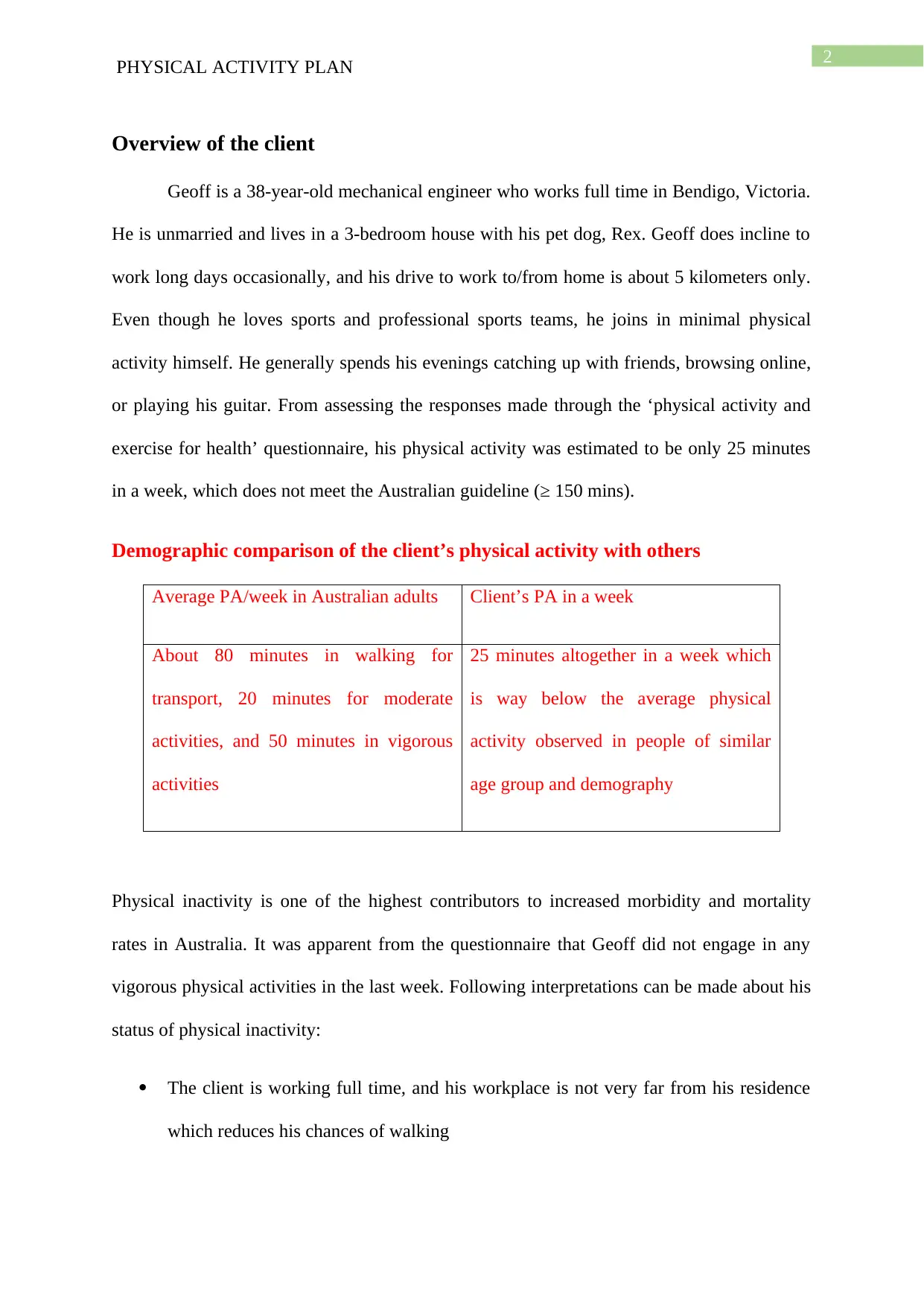
2
PHYSICAL ACTIVITY PLAN
Overview of the client
Geoff is a 38-year-old mechanical engineer who works full time in Bendigo, Victoria.
He is unmarried and lives in a 3-bedroom house with his pet dog, Rex. Geoff does incline to
work long days occasionally, and his drive to work to/from home is about 5 kilometers only.
Even though he loves sports and professional sports teams, he joins in minimal physical
activity himself. He generally spends his evenings catching up with friends, browsing online,
or playing his guitar. From assessing the responses made through the ‘physical activity and
exercise for health’ questionnaire, his physical activity was estimated to be only 25 minutes
in a week, which does not meet the Australian guideline (≥ 150 mins).
Demographic comparison of the client’s physical activity with others
Average PA/week in Australian adults Client’s PA in a week
About 80 minutes in walking for
transport, 20 minutes for moderate
activities, and 50 minutes in vigorous
activities
25 minutes altogether in a week which
is way below the average physical
activity observed in people of similar
age group and demography
Physical inactivity is one of the highest contributors to increased morbidity and mortality
rates in Australia. It was apparent from the questionnaire that Geoff did not engage in any
vigorous physical activities in the last week. Following interpretations can be made about his
status of physical inactivity:
The client is working full time, and his workplace is not very far from his residence
which reduces his chances of walking
PHYSICAL ACTIVITY PLAN
Overview of the client
Geoff is a 38-year-old mechanical engineer who works full time in Bendigo, Victoria.
He is unmarried and lives in a 3-bedroom house with his pet dog, Rex. Geoff does incline to
work long days occasionally, and his drive to work to/from home is about 5 kilometers only.
Even though he loves sports and professional sports teams, he joins in minimal physical
activity himself. He generally spends his evenings catching up with friends, browsing online,
or playing his guitar. From assessing the responses made through the ‘physical activity and
exercise for health’ questionnaire, his physical activity was estimated to be only 25 minutes
in a week, which does not meet the Australian guideline (≥ 150 mins).
Demographic comparison of the client’s physical activity with others
Average PA/week in Australian adults Client’s PA in a week
About 80 minutes in walking for
transport, 20 minutes for moderate
activities, and 50 minutes in vigorous
activities
25 minutes altogether in a week which
is way below the average physical
activity observed in people of similar
age group and demography
Physical inactivity is one of the highest contributors to increased morbidity and mortality
rates in Australia. It was apparent from the questionnaire that Geoff did not engage in any
vigorous physical activities in the last week. Following interpretations can be made about his
status of physical inactivity:
The client is working full time, and his workplace is not very far from his residence
which reduces his chances of walking
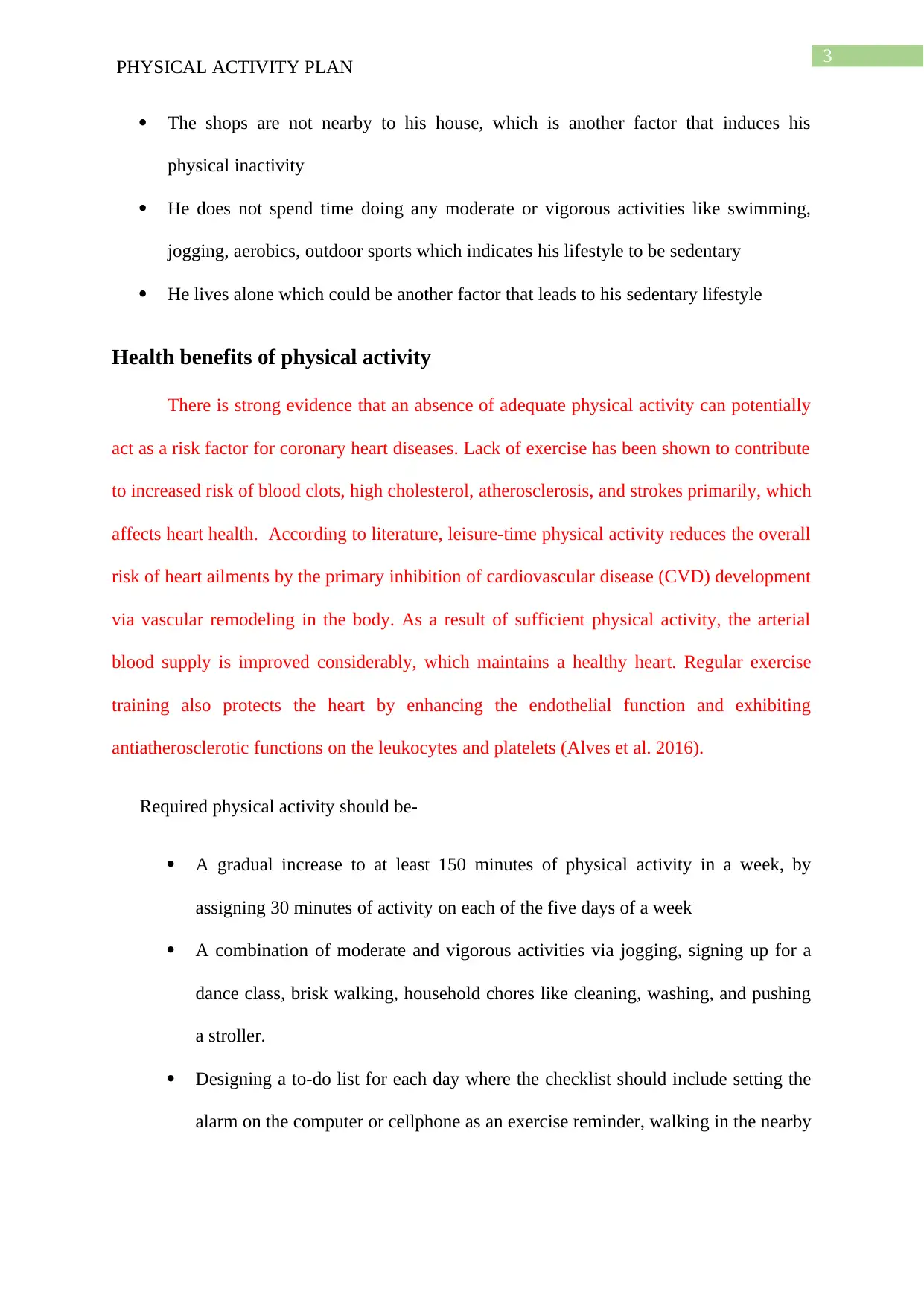
3
PHYSICAL ACTIVITY PLAN
The shops are not nearby to his house, which is another factor that induces his
physical inactivity
He does not spend time doing any moderate or vigorous activities like swimming,
jogging, aerobics, outdoor sports which indicates his lifestyle to be sedentary
He lives alone which could be another factor that leads to his sedentary lifestyle
Health benefits of physical activity
There is strong evidence that an absence of adequate physical activity can potentially
act as a risk factor for coronary heart diseases. Lack of exercise has been shown to contribute
to increased risk of blood clots, high cholesterol, atherosclerosis, and strokes primarily, which
affects heart health. According to literature, leisure-time physical activity reduces the overall
risk of heart ailments by the primary inhibition of cardiovascular disease (CVD) development
via vascular remodeling in the body. As a result of sufficient physical activity, the arterial
blood supply is improved considerably, which maintains a healthy heart. Regular exercise
training also protects the heart by enhancing the endothelial function and exhibiting
antiatherosclerotic functions on the leukocytes and platelets (Alves et al. 2016).
Required physical activity should be-
A gradual increase to at least 150 minutes of physical activity in a week, by
assigning 30 minutes of activity on each of the five days of a week
A combination of moderate and vigorous activities via jogging, signing up for a
dance class, brisk walking, household chores like cleaning, washing, and pushing
a stroller.
Designing a to-do list for each day where the checklist should include setting the
alarm on the computer or cellphone as an exercise reminder, walking in the nearby
PHYSICAL ACTIVITY PLAN
The shops are not nearby to his house, which is another factor that induces his
physical inactivity
He does not spend time doing any moderate or vigorous activities like swimming,
jogging, aerobics, outdoor sports which indicates his lifestyle to be sedentary
He lives alone which could be another factor that leads to his sedentary lifestyle
Health benefits of physical activity
There is strong evidence that an absence of adequate physical activity can potentially
act as a risk factor for coronary heart diseases. Lack of exercise has been shown to contribute
to increased risk of blood clots, high cholesterol, atherosclerosis, and strokes primarily, which
affects heart health. According to literature, leisure-time physical activity reduces the overall
risk of heart ailments by the primary inhibition of cardiovascular disease (CVD) development
via vascular remodeling in the body. As a result of sufficient physical activity, the arterial
blood supply is improved considerably, which maintains a healthy heart. Regular exercise
training also protects the heart by enhancing the endothelial function and exhibiting
antiatherosclerotic functions on the leukocytes and platelets (Alves et al. 2016).
Required physical activity should be-
A gradual increase to at least 150 minutes of physical activity in a week, by
assigning 30 minutes of activity on each of the five days of a week
A combination of moderate and vigorous activities via jogging, signing up for a
dance class, brisk walking, household chores like cleaning, washing, and pushing
a stroller.
Designing a to-do list for each day where the checklist should include setting the
alarm on the computer or cellphone as an exercise reminder, walking in the nearby
Secure Best Marks with AI Grader
Need help grading? Try our AI Grader for instant feedback on your assignments.
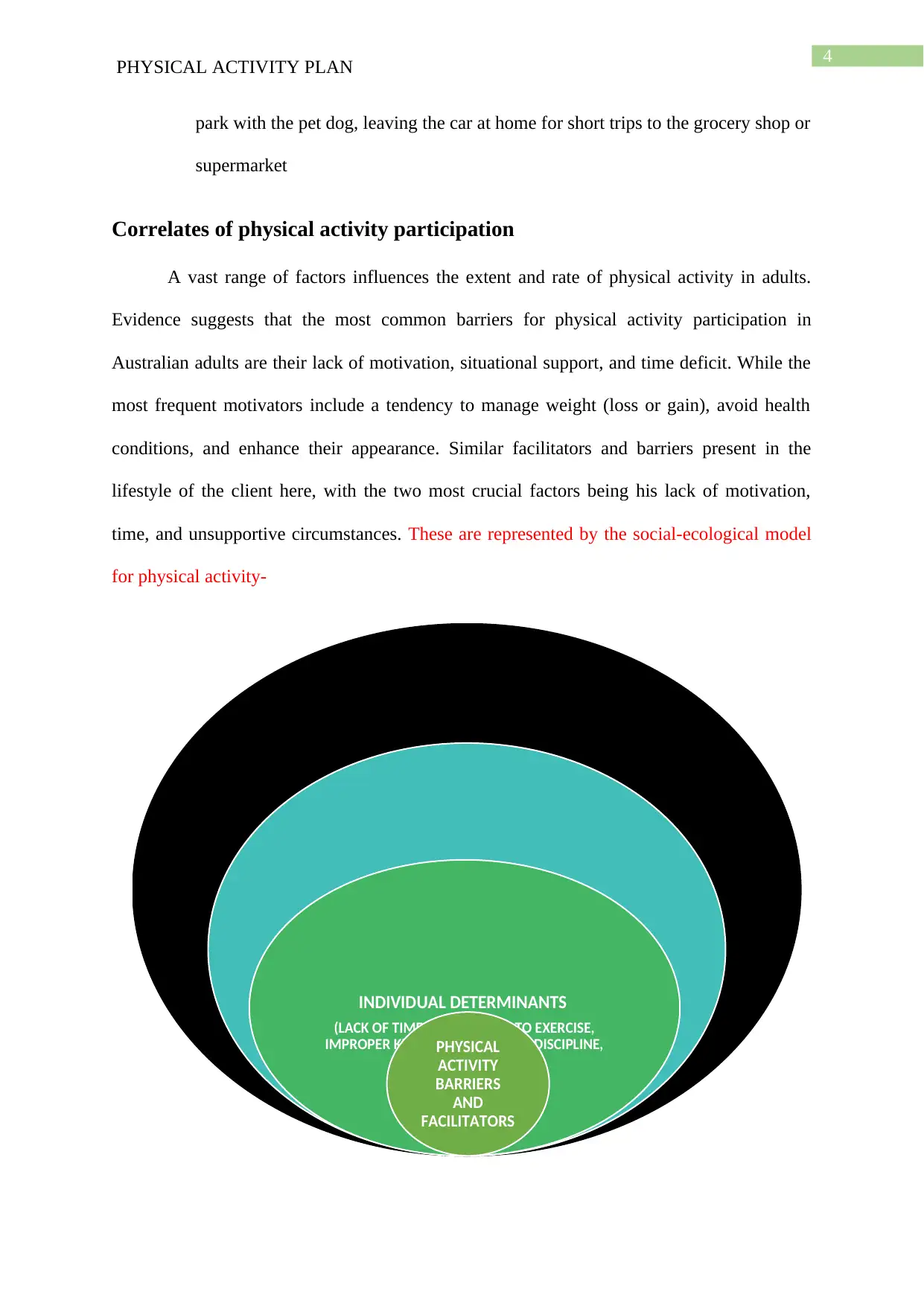
4
PHYSICAL ACTIVITY PLAN
park with the pet dog, leaving the car at home for short trips to the grocery shop or
supermarket
Correlates of physical activity participation
A vast range of factors influences the extent and rate of physical activity in adults.
Evidence suggests that the most common barriers for physical activity participation in
Australian adults are their lack of motivation, situational support, and time deficit. While the
most frequent motivators include a tendency to manage weight (loss or gain), avoid health
conditions, and enhance their appearance. Similar facilitators and barriers present in the
lifestyle of the client here, with the two most crucial factors being his lack of motivation,
time, and unsupportive circumstances. These are represented by the social-ecological model
for physical activity-
SOCIAL ENVIRONMENT (WORK PRESSURE,
SEDENTARY WORK CULTURE)
BUILT ENVIRONMENT
(LACK OF MOTIVATION FROM NEIGHBOURS, URBAN
INFRASTRUCTURE, UNINTERESTING ROADS)
INDIVIDUAL DETERMINANTS
(LACK OF TIME, MOTIVATION TO EXERCISE,
IMPROPER KNOWLEDGE, NO SELF-DISCIPLINE,
LACK OF ENERGY)
PHYSICAL
ACTIVITY
BARRIERS
AND
FACILITATORS
PHYSICAL ACTIVITY PLAN
park with the pet dog, leaving the car at home for short trips to the grocery shop or
supermarket
Correlates of physical activity participation
A vast range of factors influences the extent and rate of physical activity in adults.
Evidence suggests that the most common barriers for physical activity participation in
Australian adults are their lack of motivation, situational support, and time deficit. While the
most frequent motivators include a tendency to manage weight (loss or gain), avoid health
conditions, and enhance their appearance. Similar facilitators and barriers present in the
lifestyle of the client here, with the two most crucial factors being his lack of motivation,
time, and unsupportive circumstances. These are represented by the social-ecological model
for physical activity-
SOCIAL ENVIRONMENT (WORK PRESSURE,
SEDENTARY WORK CULTURE)
BUILT ENVIRONMENT
(LACK OF MOTIVATION FROM NEIGHBOURS, URBAN
INFRASTRUCTURE, UNINTERESTING ROADS)
INDIVIDUAL DETERMINANTS
(LACK OF TIME, MOTIVATION TO EXERCISE,
IMPROPER KNOWLEDGE, NO SELF-DISCIPLINE,
LACK OF ENERGY)
PHYSICAL
ACTIVITY
BARRIERS
AND
FACILITATORS
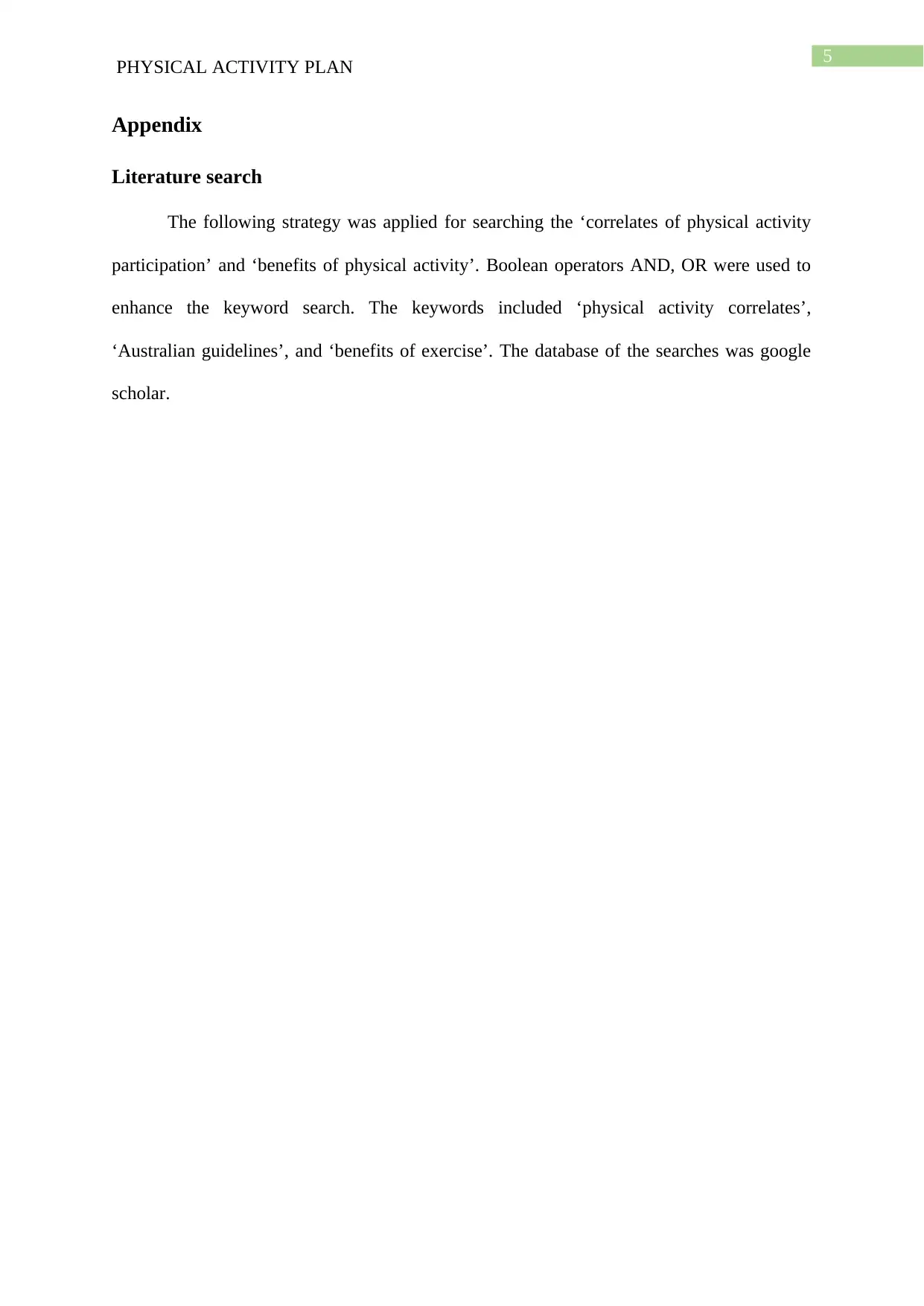
5
PHYSICAL ACTIVITY PLAN
Appendix
Literature search
The following strategy was applied for searching the ‘correlates of physical activity
participation’ and ‘benefits of physical activity’. Boolean operators AND, OR were used to
enhance the keyword search. The keywords included ‘physical activity correlates’,
‘Australian guidelines’, and ‘benefits of exercise’. The database of the searches was google
scholar.
PHYSICAL ACTIVITY PLAN
Appendix
Literature search
The following strategy was applied for searching the ‘correlates of physical activity
participation’ and ‘benefits of physical activity’. Boolean operators AND, OR were used to
enhance the keyword search. The keywords included ‘physical activity correlates’,
‘Australian guidelines’, and ‘benefits of exercise’. The database of the searches was google
scholar.
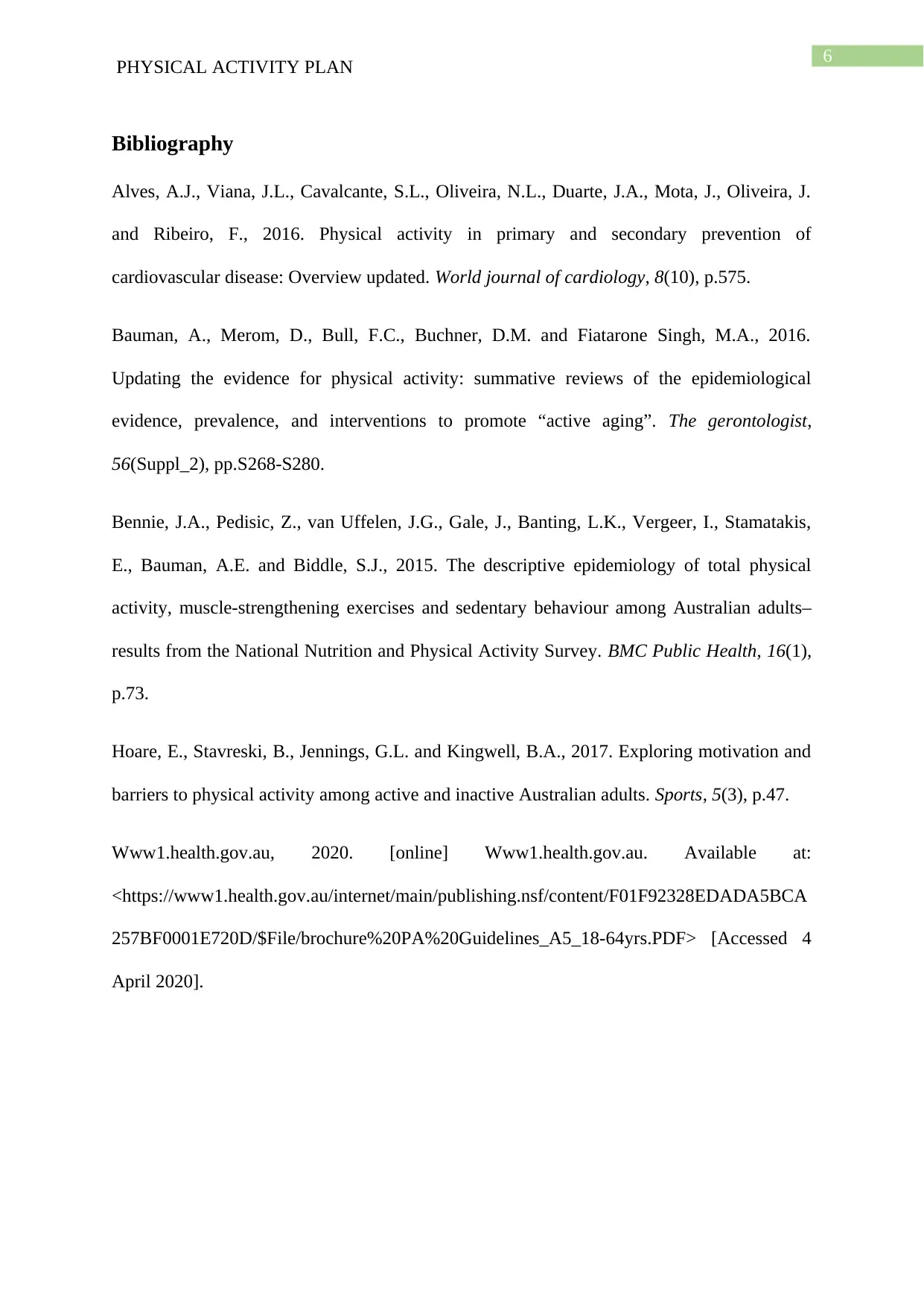
6
PHYSICAL ACTIVITY PLAN
Bibliography
Alves, A.J., Viana, J.L., Cavalcante, S.L., Oliveira, N.L., Duarte, J.A., Mota, J., Oliveira, J.
and Ribeiro, F., 2016. Physical activity in primary and secondary prevention of
cardiovascular disease: Overview updated. World journal of cardiology, 8(10), p.575.
Bauman, A., Merom, D., Bull, F.C., Buchner, D.M. and Fiatarone Singh, M.A., 2016.
Updating the evidence for physical activity: summative reviews of the epidemiological
evidence, prevalence, and interventions to promote “active aging”. The gerontologist,
56(Suppl_2), pp.S268-S280.
Bennie, J.A., Pedisic, Z., van Uffelen, J.G., Gale, J., Banting, L.K., Vergeer, I., Stamatakis,
E., Bauman, A.E. and Biddle, S.J., 2015. The descriptive epidemiology of total physical
activity, muscle-strengthening exercises and sedentary behaviour among Australian adults–
results from the National Nutrition and Physical Activity Survey. BMC Public Health, 16(1),
p.73.
Hoare, E., Stavreski, B., Jennings, G.L. and Kingwell, B.A., 2017. Exploring motivation and
barriers to physical activity among active and inactive Australian adults. Sports, 5(3), p.47.
Www1.health.gov.au, 2020. [online] Www1.health.gov.au. Available at:
<https://www1.health.gov.au/internet/main/publishing.nsf/content/F01F92328EDADA5BCA
257BF0001E720D/$File/brochure%20PA%20Guidelines_A5_18-64yrs.PDF> [Accessed 4
April 2020].
PHYSICAL ACTIVITY PLAN
Bibliography
Alves, A.J., Viana, J.L., Cavalcante, S.L., Oliveira, N.L., Duarte, J.A., Mota, J., Oliveira, J.
and Ribeiro, F., 2016. Physical activity in primary and secondary prevention of
cardiovascular disease: Overview updated. World journal of cardiology, 8(10), p.575.
Bauman, A., Merom, D., Bull, F.C., Buchner, D.M. and Fiatarone Singh, M.A., 2016.
Updating the evidence for physical activity: summative reviews of the epidemiological
evidence, prevalence, and interventions to promote “active aging”. The gerontologist,
56(Suppl_2), pp.S268-S280.
Bennie, J.A., Pedisic, Z., van Uffelen, J.G., Gale, J., Banting, L.K., Vergeer, I., Stamatakis,
E., Bauman, A.E. and Biddle, S.J., 2015. The descriptive epidemiology of total physical
activity, muscle-strengthening exercises and sedentary behaviour among Australian adults–
results from the National Nutrition and Physical Activity Survey. BMC Public Health, 16(1),
p.73.
Hoare, E., Stavreski, B., Jennings, G.L. and Kingwell, B.A., 2017. Exploring motivation and
barriers to physical activity among active and inactive Australian adults. Sports, 5(3), p.47.
Www1.health.gov.au, 2020. [online] Www1.health.gov.au. Available at:
<https://www1.health.gov.au/internet/main/publishing.nsf/content/F01F92328EDADA5BCA
257BF0001E720D/$File/brochure%20PA%20Guidelines_A5_18-64yrs.PDF> [Accessed 4
April 2020].
Paraphrase This Document
Need a fresh take? Get an instant paraphrase of this document with our AI Paraphraser

7
PHYSICAL ACTIVITY PLAN
PHYSICAL ACTIVITY PLAN
1 out of 8
Related Documents
Your All-in-One AI-Powered Toolkit for Academic Success.
+13062052269
info@desklib.com
Available 24*7 on WhatsApp / Email
![[object Object]](/_next/static/media/star-bottom.7253800d.svg)
Unlock your academic potential
© 2024 | Zucol Services PVT LTD | All rights reserved.





